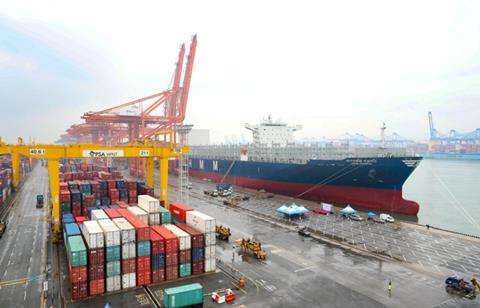Freshfel hosts a webinar discussing sustainable and reliable logistics infrastructure for fresh produce
Freshfel Europe has said that global logistics is expected to turn a corner in 2023 with the increased availability of containers and ships and some easing of the bottlenecks and delays that have been prominent during the past years.

However, for the fresh produce sector, there is still a need for the optimisation of transport networks, the fresh produce body noted.
On 18 January, Freshfel Europe organised a webinar on the topic of logistics in Europe and beyond, featuring guest speakers from the World Shipping Council, Freshrail, and Easyfresh logistics.
During the webinar Freshfel and its members highlighted the need for affordable and reliable well-connected multimodal transport networks, while emphasising sustainable solutions to continue the journey towards decarbonisation.
”Every year, close to 50m tonnes of fresh fruit and vegetables are distributed locally within the Member State of the European Union where it was grown, while 29m tonnes are traded intra-EU,” Freshfel highlighted. ”Furthermore, the EU exports around 7m tonnes of fresh fruits and vegetables annually, and imports almost double.
”Logistics must be timely and well-connected to ensure that all these products arrive fresh and in good quality. To guarantee a wide distribution of fresh fruits and vegetables, transport networks and reefer/container availability must be well-functioning on all levels: locally, nationally, regionally, and globally.”
The meeting highlighted the importance of public and private sector support and investment in multimodal transport networks, and sustainable and affordable logistics solutions, for fresh produce to reach their destinations in a timely manner with optimal quality.
The webinar heard that between 2020 and 2022, the demand for global logistics had its operational normality disrupted.
This was the result of lockdowns and increased controls, then a booming demand during post-Covid-19, which created a 0 per cent idle shipping fleet, an increase of 7.5 per cent in port and hinterland congestion, and a 25 per cent backlog on orders of new vessels.
Inflation, lack of truck drivers and other logistics talents, along with rising fuel prices have caused cost increases for fresh fruit and vegetables logistics.
“Higher logistics costs due to the scarcity of containers and trucks, and higher fuel costs impact the affordability of logistics, leading to missed trade opportunities,” said Freshfel Europe general delegate Philippe Binard.
”Covering these added costs is challenging for the sector which is working with small margins and exposed to the high financial pressures of last year. This will still be noticeable for some time to come.
”For 2023 however, global logistics seem to be turning a corner with fewer logistical bottlenecks, leading to a better outlook for the sector to seize opportunities in the market,” he outlined.
Not only is the backlog of vessels and container orders slowly being resolved, but a drop in demand has also made more of the existing logistics equipment available, which in turn has decreased congestion and increased global schedule reliability.
Despite this, Freshfel Europe noted that although the situation was improving it had not recovered, and the reliability of timeliness for fresh produce transport was still significantly lower than before the pandemic.
“As fresh fruits and vegetables are perishable goods, disruptions and delays negatively affect product quality and shelf life and increase food loss and food waste,” Binard continued.
”It is essential to secure networks and infrastructure for fresh produce logistics and to better monitor global market volatility. To secure better planning, and to soften pressure in case of crisis, the use of green corridors should be pursued to allow the prioritisation of fresh produce flows.”
Freshfel said that the sector would also have to mitigate the impact of proliferating strike actions around the world that could impact the fluidity of perishable product flow.
The sector called for the optimisation of EU and international route networks, making use of multimodal solutions and securing more direct journeys to some long-distance destinations, namely for export to Asia or Latin America.
Transporting fresh produce from Europe to Asia through transit hubs could take up to 40 days, a journey that through a direct line could be made much shorter, Freshfel said.
This could prevent putting product quality at risk and increase trade opportunities while decreasing emissions.
The fresh produce sector is aiming to make use of the range of available transport alternatives, including modal shift towards inland rail that could contribute to reducing CO2 emissions.
Meanwhile, the fresh produce sector is continuously aiming to reduce its environmental footprint and emissions and is now considering some of the new measures emanating from the EU.
“The impact of measures such as slower steaming, more expensive gas or new taxation resulting from the Carbon Border Adjustment Mechanism and EU ETS will have to be monitored,” Binard added.
Freshfel said that the sustainable transport of fresh produce to different market outlets, from the shorter destinations to the most distant, was essential to providing consumers with a diversity of fresh produce for their healthy diet.



